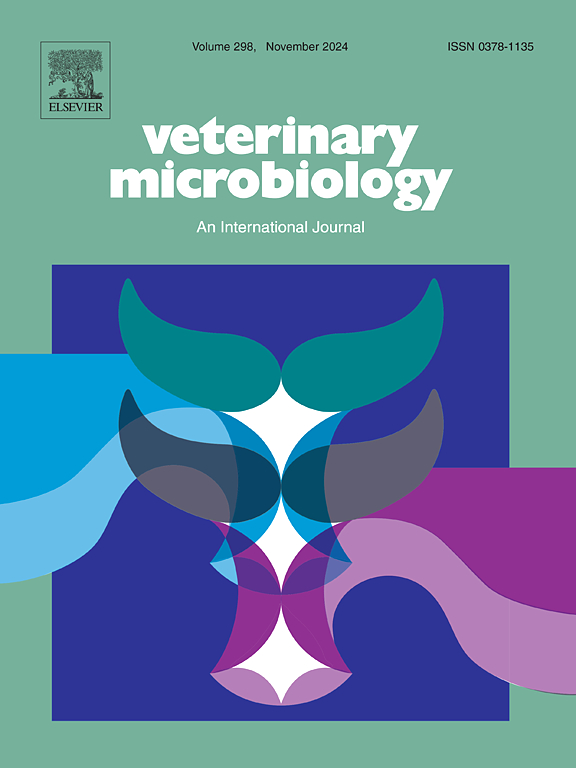冻干抗狂犬病mRNA-LNP疫苗单次皮下注射可诱导早期和强大的免疫应答
IF 2.4
2区 农林科学
Q3 MICROBIOLOGY
引用次数: 0
摘要
狂犬病是由狂犬病毒(RABV)引起的人畜共患疾病。RABV感染对中枢神经系统造成严重破坏,造成致命后果,这促使全球努力开发一种高效和安全的疫苗。目前,使用最广泛的疫苗是灭活疫苗,需要多次注射,用于暴露前预防或暴露后免疫。这就增加了很多不必要的麻烦和人工成本。mRNA疫苗是对抗新发和再发传染病的一个有希望的平台,因为它们可以诱导高水平的病毒中和抗体(VNAs)。在本研究中,我们通过优化的mRNA制备工艺获得了狂犬病糖蛋白mRNA分子的高效表达,并被脂质纳米颗粒(LNP)包裹,称为mRNA-LNP疫苗。单剂量mRNA-LNP在小鼠中具有高度的免疫原性,并诱导了快速的保护性抗体反应。抗体在抵抗致命RABV感染和通过阻止病毒入侵中枢神经系统来消除病毒方面发挥着关键作用。与获得许可的灭活疫苗相比,一剂mRNA-LNP疫苗在狗和猫体内诱导的VNA滴度更高、更持久,有趣的是,猫体内的抗体滴度高于狗。与新鲜制备的疫苗相比,冻干疫苗的免疫原性没有明显下降,可在- 20℃下保存4个月。以上结果表明,mRNA-LNP疫苗安全有效,单次给药对狗和猫均表现出较强的免疫应答,有望成为狂犬病的候选疫苗。本文章由计算机程序翻译,如有差异,请以英文原文为准。
A lyophilized anti-rabies mRNA-LNP vaccine induces early and robust immune responses from a single-dose subcutaneous administration
Rabies is a zoonotic disease caused by the rabies virus (RABV). RABV infections cause severe destruction to the central nervous system with fatal consequences, which has prompted global efforts to develop a highly effective and safe vaccine. Currently, the most widely used vaccines are inactivated vaccines, which need multiple injected doses for either pre-exposure prophylaxis or post-exposure immunization. This adds a lot of unnecessary trouble and labor costs. mRNA vaccines represent a promising platform against emerging and re-emerging infectious diseases, because they can induce high levels of virus-neutralizing antibodies (VNAs). In this study, we obtained a highly effective expression of rabies glycoprotein mRNA molecule by the optimized mRNA preparation procedure and encapsulated with lipid nanoparticles (LNP), termed mRNA-LNP vaccine. A single dose of the mRNA-LNP was highly immunogenic and induced a rapid protective antibody response in mice. Antibodies play a pivotal role in protecting against lethal RABV infections and eliminate the virus by blocking it from invading the CNS. One dose of the mRNA-LNP vaccine induced higher and more durable VNA titers in dogs and cats compared with the licensed inactivated vaccines, intriguingly, the antibody titers were higher in cats than in dogs. Furthermore, the immunogenicity of the freeze-dried vaccine was not significantly declined when compared with a freshly prepared vaccine, and it can be stored at −20℃ for 4 months. All the above results show that the mRNA-LNP vaccine is safe and effectively exhibited robust immune responses both for dogs and cats with a single-dose administration, which being promising to be a candidate vaccine against rabies.
求助全文
通过发布文献求助,成功后即可免费获取论文全文。
去求助
来源期刊

Veterinary microbiology
农林科学-兽医学
CiteScore
5.90
自引率
6.10%
发文量
221
审稿时长
52 days
期刊介绍:
Veterinary Microbiology is concerned with microbial (bacterial, fungal, viral) diseases of domesticated vertebrate animals (livestock, companion animals, fur-bearing animals, game, poultry, fish) that supply food, other useful products or companionship. In addition, Microbial diseases of wild animals living in captivity, or as members of the feral fauna will also be considered if the infections are of interest because of their interrelation with humans (zoonoses) and/or domestic animals. Studies of antimicrobial resistance are also included, provided that the results represent a substantial advance in knowledge. Authors are strongly encouraged to read - prior to submission - the Editorials (''Scope or cope'' and ''Scope or cope II'') published previously in the journal. The Editors reserve the right to suggest submission to another journal for those papers which they feel would be more appropriate for consideration by that journal.
Original research papers of high quality and novelty on aspects of control, host response, molecular biology, pathogenesis, prevention, and treatment of microbial diseases of animals are published. Papers dealing primarily with immunology, epidemiology, molecular biology and antiviral or microbial agents will only be considered if they demonstrate a clear impact on a disease. Papers focusing solely on diagnostic techniques (such as another PCR protocol or ELISA) will not be published - focus should be on a microorganism and not on a particular technique. Papers only reporting microbial sequences, transcriptomics data, or proteomics data will not be considered unless the results represent a substantial advance in knowledge.
Drug trial papers will be considered if they have general application or significance. Papers on the identification of microorganisms will also be considered, but detailed taxonomic studies do not fall within the scope of the journal. Case reports will not be published, unless they have general application or contain novel aspects. Papers of geographically limited interest, which repeat what had been established elsewhere will not be considered. The readership of the journal is global.
 求助内容:
求助内容: 应助结果提醒方式:
应助结果提醒方式:


